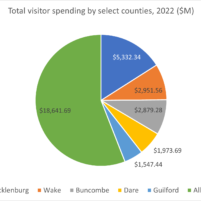
Understanding the impact of North Carolina’s tourism economy
Thanks for joining us this morning.
Most North Carolina visuals showcase our state’s natural beauty – the mountains, the beaches, the rivers. People around the country find it compelling: Only seven states see more travel spending than North Carolina.
This morning, we’re diving into the state’s tourism economy with a bit of a different approach. Rather than putting 800 words in front of you, we’re going to tell much of the story with charts, maps, and graphs. Much of the data used for the visualizations comes economic impact studies prepared for Visit North Carolina by Tourism Economics.
A few themes, we think, will emerge.
One, it’s glaringly obvious that a handful of counties comprise the vast majority of the state’s tourism economy. This is intuitive, but it still seems to add just a bit more perspective to see map after map with the same five counties shaded in.
Two, though Dare County falls into the top five on most measures, three coastal counties – Dare, New Hanover, and Brunswick – combined often out-measure the others. Coastal North Carolina’s visitor spending is dispersed from the Outer Banks to Cape Fear.
Three, the final map shows each county’s tax savings per resident caused by visitor spending – in effect, how much of the tax burden is borne by visitors as opposed to residents. As you will see, though tourism is generally concentrated among a handful of counties, the entire state benefits rather equitably from the tourism economy.
Total visitor spending by county, 2022
| County | Visitor Spending ($M) |
| Mecklenburg | $5,332.34 |
| Wake | $2,951.56 |
| Buncombe | $2,879.28 |
| Dare | $1,973.69 |
| Guilford | $1,547.44 |
| Dare + New Hanover + Brunswick | $4,124.85 |
Five counties dominate, but Mecklenburg stands well above the rest. In a theme that will become more apparent, the five counties generally anchor one region of the state.
State taxes generated from visitor spending by county, 2022

| County | State Taxes ($M) |
| Mecklenburg | $189.60 |
| Wake | $139.70 |
| Buncombe | $133.10 |
| Dare | $66.00 |
| Guilford | $58.10 |
| Dare + New Hanover + Brunswick | $135.40 |
If this maps looks nearly identical, it’s because it is. But for some small variations, visitor spending – naturally – yields similar state tax revenue.
Visitor spending on retail by county, 2022

| County | Retail Spending ($M) |
| Buncombe | $534.30 |
| Wake | $524.07 |
| Mecklenburg | $390.83 |
| Dare | $175.52 |
| Guilford | $118.31 |
| Dare + New Hanover + Brunswick | $357.27 |
On retail spending, the same five counties dominate, though Buncombe leads the pack.
Visitor spending on lodging by county, 2022

| County | Lodging Spending ($M) |
| Mecklenburg | $1,218.05 |
| Buncombe | $901.65 |
| Wake | $704.96 |
| Dare | $553.14 |
| Guilford | $317.52 |
| Dare + New Hanover + Brunswick | $1,113.03 |
Visitor spending on recreation by county, 2022

| County | Recreation Spending ($M) |
| Mecklenburg | $642.71 |
| Wake | $527.63 |
| Buncombe | $334.91 |
| Dare | $260.17 |
| Guilford | $175.01 |
| Dare + New Hanover + Brunswick | $527.26 |
State/local tax savings per resident from visitor spending, 2022

| County | Tax Savings Per Resident |
| Dare | $3,696.7 |
| Swain | $1,611.04 |
| Currituck | $1,208.03 |
| Hyde | $985.23 |
| Avery | $966.92 |
This map tells a far different story than the previous five. It shows the per capita “tax savings” by county – a measure of how much visitors, as opposed to residents, contributed to the tax base in each county.
Dare County sits high above the rest because of its strong tourism industry and low population. It actually outmatches the 44 lowest counties combined.
Aside from that outlier, the map suggests the benefits of the tourism economy are well-shared across the state.
We’ll leave you with one more visualization: the total visitor spending of the top five counties compared to every other county combined.

Recent Articles
When Prayers are Heard, Answers Come: Finding Peace in Times of Crisis
From the Desk of Chuck Fuller “Our prayers, sir, were heard, and they were graciously answered” Many years ago, I led a task force responding to a series of tornados that devastated parts of eastern North Carolina. In our early discussions, we debated how many people needed to be impacted for us to implement a…
Read MorePassenger rail’s future in North Carolina
Thank you for joining us this Saturday morning. America once led the world in train travel. Routes spanned the continent and most people had easy access to a train station. But trains gave way to cars and planes, and by the 1960s privately owned train companies were bleeding revenue. In 1970, Congress passed and President Richard Nixon…
Read MoreThe Golden LEAF Foundation and North Carolina
Thank you for joining us this Saturday morning. Today we’re diving into one of the most impactful North Carolina organizations of the past 25 years: Goldean LEAF (“LEAF” stands for long-term economic advancement foundation)The nonprofit has largely flown under the radar for the past decade. That lack of public attention or controversy should be seen…
Read More
